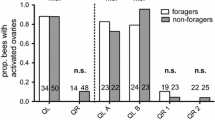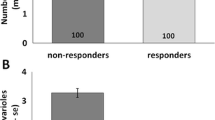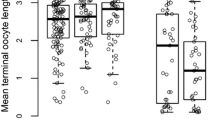Abstract
Reproduction in social insect societies reflects a delicate balance between cooperation and conflict over offspring production, and worker reproduction is widespread even in species showing strong reproductive skew in favor of the queen. To navigate these conflicts, workers are predicted to develop the means to estimate the queen’s fecundity - potentially through behavioral and/or chemical cues - and to adjust their reproduction to maximize their fitness. Here, we introduced bumble bee, Bombus impatiens, workers to queens of different mating and reproductive status and examined worker reproduction and expression levels of two genes which were previously shown to be sensitive to the presence of the queen, vitellogenin and Krüppel-homolog 1. We further explored whether the queen’s chemical secretion alone is sufficient to regulate worker reproduction, aggression and gene expression. We found that worker ovary activation was inhibited only in the presence of egg-laying queens, regardless of their mating status. Workers reared in the presence of newly-mated queens showed intermediate vitellogenin expression levels relative to workers reared with mated egg-laying and virgin queens. However, none of the whole-body chemical extracts of any of the queen treatment groups affected ovary activation, aggressive behavior, or gene expression in workers. Our findings indicate that only the presence of a freely-behaving, egg-laying queen can fully inhibit worker reproduction. It remains to be determined if workers detect differences in queen mating status and fecundity through differences in the queens’ behavior alone or through the queen’s behavior in concert with fertility signals.




Similar content being viewed by others
References
Alaux C, Jaisson P, Hefetz A (2004) Queen influence on worker reproduction in bumblebees (Bombus terrestris) colonies. Insect Soc 51:287–293
Alaux C, Jaisson P, Hefetz A (2006) Regulation of worker reproduction in bumblebees (Bombus terrestris): workers eavesdrop on a queen signal. Behav Ecol Sociobiol 60:439–446
Amsalem E, Hefetz A (2010) The appeasement effect of sterility signaling in dominance contests among Bombus terrestris workers. Behav Ecol Sociobiol 64:1685–1694
Amsalem E, Hefetz A (2011) The effect of group size on the interplay between dominance and reproduction in Bombus terrestris. PLoS One 6:e18238
Amsalem E, Kiefer J, Schulz S, Hefetz A (2014a) The effect of caste and reproductive state on the chemistry of the cephalic labial glands secretion of Bombus terrestris. J Chem Ecol 40:900–912
Amsalem E, Malka O, Grozinger C, Hefetz A (2014b) Exploring the role of juvenile hormone and vitellogenin in reproduction and social behavior in bumble bees. BMC Evol Biol 14:45
Amsalem E, Orlova M, Grozinger CM (2015a) A conserved class of queen pheromones? Re-evaluating the evidence in bumblebees (Bombus impatiens). Proc R Soc B 282:20151800
Amsalem E, Galbraith DA, Cnaani J, Teal PEA, Grozinger CM (2015b) Conservation and modification of genetic and physiological toolkits underpinning diapause in bumble bee queens. Mol Ecol 24:5596–5615
Amsalem E, Grozinger CM, Padilla M, Hefetz A (2015c) Chapter two - the physiological and genomic bases of bumble bee social behaviour. In: Amro Z, Clement FK (eds) Advances in insect physiology, vol 48. Academic Press, Amsterdam, pp 37–93
Bloch G (1999) Regulation of queen-worker conflict in bumble-bee (Bombus terrestris) colonies. Proc R Soc B 266:2465–2469
Bloch G, Hefetz A (1999) Reevaluation of the role of mandibular glands in regulation of reproduction in bumblebee colonies. J Chem Ecol 25:881–896
Bortolotti L, Duchateau MJ, Sbrenna G (2001) Effect of juvenile hormone on caste determination and colony processes in the bumblebee Bombus terrestris. Entomologia Experimentalis et Applicata 101:143–158
Bourke AFG (1994) Worker matricide in social bee and wasps. J Theor Biol 167:283–292
Cnaani J, Robinson GE, Bloch G, Borst D, Hefetz A (2000) The effect of queen-worker conflict on caste determination in the bumblebee Bombus terrestris. Behav Ecol Sociobiol 47:346–352
Cnaani J, Schmid-Hempel R, Schmidt JO (2002) Colony development, larval development and worker reproduction in Bombus impatiens cresson. Insect Soc 49:164–170
Duchateau MJ, Velthuis HHW (1988) Development and reproductive strategies in Bombus terrestris colonies. Behavior 107:186–207
Duchateau MJ, Velthuis HHW, Boomsma JJ (2004) Sex ratio variation in the bumblebee Bombus terrestris. Behav Ecol 15:71–82
Galbraith DA, Wang Y, Amdam GV, Page RE, Grozinger CM (2015) Reproductive physiology mediates honey bee (Apis mellifera) worker responses to social cues. Behav Ecol Sociobiol 69:1511–1518
Hamilton WD (1972) Altruism and related phenomena mainly in the social insects. Annu Rev Ecol Syst 2:193–232
Hammond RL, Keller L (2004) Conflict over male parentage in social insects. PLoS Biol 2:1472–1482
Holman L (2014) Bumblebee size polymorphism and worker response to queen pheromone. Peer J 2:e604
Honk van CGJ, Velthuis HHW, Roseler PF, Malotaux ME (1980) The mandibular glands of Bombus terrestris queens as a source of queen pheromone. Entomologia Experimentalis et Applicata 28:191–198
Hoover SE, Keeling CI, Winston ML, Slessor KN (2003) The effect of queen pheromones on worker honey bee ovary development. Naturwissenschaften 90:477–480
Hornakova D, Matouskova P, Kindl J, Valterova I, Pichova I (2010) Selection of reference genes for real-time polymerase chain reaction analysis in tissues from Bombus terrestris and Bombus lucorum of different ages. Anal Biochem 397:118–120
Jedlička P, Ernst UR, Votavová A, Hanus R, Valterová I (2016) Gene expression dynamics in major endocrine regulatory pathways along the transition from solitary to social life in a bumblebee, Bombus terrestris. Front Physiol 7:574
Jindra M, Palli SR, Riddiford LM (2013) The juvenile hormone signaling pathway in insect development. Annu Rev Entomol 58:181–204
Keller L, Nonacs P (1993) The role of queen pheromone in social insects: queen control or queen signal? Anim Behav 45:787–794
Kocher SD, Grozinger CM (2011) Cooperation, conflict, and the evolution of queen pheromones. J Chem Ecol 37:1263–1275
Kocher SD, Richard F-J, Tarpy DR, Grozinger CM (2009) Queen reproductive state modulates pheromone production and queen-worker interactions in honeybees. Behav Ecol 20:1007–1014
Kocher SD, Ayroles JF, Stone EA, Grozinger CM (2010) Individual variation in pheromone response correlates with reproductive traits and brain gene expression in worker honey bees. PLoS One 5:e9116
Lofgren CS, Glancey BM, Glover A, Rocca J, Tumlinson J (1983) Behavior of workers of Solenopsis invicta (hymenoptera: Formicidae) to the queen recognition pheromone: laboratory studies with an olfactometer and surrogate queens. Ann Entomol Soc Am 76:44–50
Mattila Heather R, Reeve HK, Smith ML (2012) Promiscuous honey bee queens increase colony productivity by suppressing worker selfishness. Curr Biol 22:2027–2031
Mattila HR, Seeley TD (2007) Genetic diversity in honeybee colonies enhances productivity and fitness. Science 317:362–364
Niño EL, Malka O, Hefetz A, Tarpy DR, Grozinger CM (2013) Chemical profiles of two pheromone glands are differentially regulated by distinct mating factors in honey bee queens (Apis mellifera l.). PloS one 8:e78637
Nunes TM et al (2014) Queen signals in a stingless bee: suppression of worker ovary activation and spatial distribution of active compounds. Sci Rep-UK 4:7449
Padilla M, Amsalem E, Altman N, Hefetz A, Grozinger CM (2016) Chemical communication is not sufficient to explain reproductive inhibition in the bumblebee Bombus impatiens. Roy Soc Open Sci 3:160576. doi:10.1098/rsos.160576
Peso M, Niño EL, Grozinger CM, Barron AB (2013) Effect of honey bee queen mating condition on worker ovary activation. Insect Soc 60:123–133
Richard F-J, Tarpy DR, Grozinger CM (2007) Effects of insemination quantity on honey bee queen physiology. PLoS One 2:e980
Richard F-J, Schal C, Tarpy DR, Grozinger CM (2011) Effects of instrumental insemination and insemination quantity on dufour’s gland chemical profiles and vitellogenin expression in honey bee queens (Apis mellifera). J Chem Ecol 37:1027–1036
Roseler PF (1985) A technique for year-round rearing of Bombus terrestris (Apidae, Bombini) colonies in captivity. Apidologie 16:165–170
Rottler-Hoermann A-M, Schulz S, Ayasse M (2016) Nest wax triggers worker reproduction in the bumblebee Bombus terrestris. Roy Soc Open Sci 3:150599. doi:10.1098/rsos.150599
Seeley TD, Tarpy DR (2007) Queen promiscuity lowers disease within honeybee colonies. Proc R Soc B 274:67–72
Shpigler H, Patch HM, Cohen M, Fan Y, Grozinger CM, Bloch G (2010) The transcription factor kruppel homolog 1 is linked to hormone mediated social organization in bees. BMC Evol Biol 10:120
Sramkova A, Schulz C, Twele R, Francke W, Ayasse M (2008) Fertility signals in the bumblebee Bombus terrestris (hymenoptera: Apidae). Naturwissenschaften 95:515–522
Tarpy DR, Nielsen D (2002) Sampling error, effective paternity, and estimating the genetic structure of honey bee colonies (hymenoptera: Apidae). Ann Entomol Soc Am 95:513–528
Van Oystaeyen A et al (2014) Conserved class of queen pheromones stops social insect workers from reproducing. Science 343:287–290
Woyciechowski M, Łomnicki A (1987) Multiple mating of queens and the sterility of workers among eusocial hymenoptera. J Theor Biol 128:317–327
Zanette LRS, Miller SDL, Faria CMA, Almond EJ, Huggins TJ, Jordan WC, Bourke AFG (2012) Reproductive conflict in bumblebees and the evolution of worker policing. Evolution 66:3765–3777
Acknowledgements
We would like to thank the Grozinger lab for helpful discussions and Nate McCartney (Tumlinson Lab, Penn State University) for assistance in designing the equipment used in Experiment 2. M. P. was supported by a Bunton-Waller Graduate Award from Penn State University. E.A. was supported by a United States - Israel Binational Agricultural Research and Development Fund Vaadia–BARD Postdoctoral Fellowship (FI-49113). This research was supported by funding from the United States–Israel Binational Science Foundation (grant #2013104) to C.M.G., N.A. and A.H.
Author information
Authors and Affiliations
Corresponding author
Electronic supplementary material
ESM 1
(DOCX 14 kb)
Rights and permissions
About this article
Cite this article
Amsalem, E., Padilla, M., Schreiber, P.M. et al. Do Bumble Bee, Bombus impatiens, Queens Signal their Reproductive and Mating Status to their Workers?. J Chem Ecol 43, 563–572 (2017). https://doi.org/10.1007/s10886-017-0858-4
Received:
Revised:
Accepted:
Published:
Issue Date:
DOI: https://doi.org/10.1007/s10886-017-0858-4




